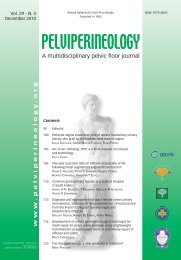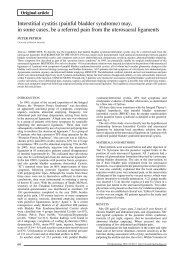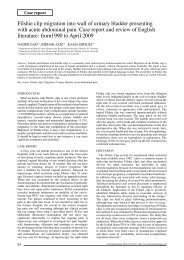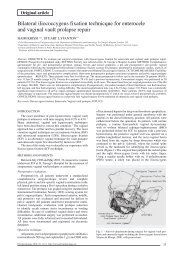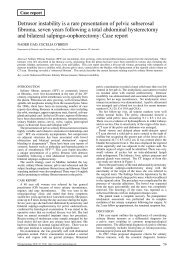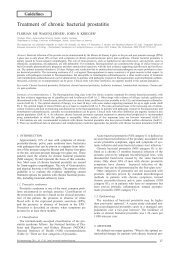This Issue Complete PDF - Pelviperineology
This Issue Complete PDF - Pelviperineology
This Issue Complete PDF - Pelviperineology
Create successful ePaper yourself
Turn your PDF publications into a flip-book with our unique Google optimized e-Paper software.
Editorial<br />
PELVIC FLOOR IMAGING<br />
Recent milestones in surgical techniques and the development of new operative materials and<br />
implants for use in coloproctology and urogynaecology, together with advances in molecular diagnostics<br />
and laboratory testing have revolutionized the management of patients with pelvic floor disorders. The<br />
assessment of urogynaecological and coloproctological operations, the surgical techniques themselves<br />
and the outcomes of these treatments are areas of great interest in the literature. Significant variations in<br />
the results of surgery have been reported and this may be because the initial choice of surgical procedure<br />
and the assessment of outcomes are based on a traditional clinical assessment. History and physical<br />
examination can be subjective and vary greatly between different specialties and even individual<br />
surgeons. Such assessments may be unreliable despite recent efforts to standardize clinical history<br />
and examination using the Pelvic Organ Prolapse quantification system (POPQ) and standardized<br />
questionnaires. New imaging technology offers an opportunity to improve our follow up of patients<br />
and so obtain a better estimation of the true incidence of unsuccessful operations and postoperative<br />
complications.<br />
In recent years there has been dramatic improvement in imaging techniques of the pelvic floor.<br />
Modalities such as magnetic resonance imaging, high-resolution endoanal, endorectal and endovaginal<br />
three-dimensional ultrasonography and dynamic and 3/4D transperineal ultrasound provide superior<br />
depiction of the pelvic anatomy and also help in understanding pathologic and functional changes that<br />
occur in pelvic floor disorders. Despite these improvements pelvic floor abnormalities, which are very<br />
common in women and are a great social problem, are still not always diagnosed. The causes of<br />
urinary and fecal incontinence and pelvic organ prolapse are not fully understood and there are still<br />
many questions unanswered in pelvic physiology and pathophysiology. The use of diagnostic imaging<br />
in both preoperative assessment and post-operative monitoring of the effects of surgical treatment<br />
offers great potential. Better availability of diagnostic imaging encourages its wider clinical usage<br />
and many clinicians now believe that in modern surgical practice a proper pre-operative imaging<br />
assessment should be performed.<br />
The increased interest in imaging by all the specialties associated with pelvic floor medicine has<br />
prompted us to create a Section on “Pelvic Floor Imaging” in future issues of <strong>Pelviperineology</strong>. All the<br />
topics concerning new developments in existing technologies along with the new technologies in<br />
pelvic floor imaging will be covered. We will start with the description of normal anatomy and<br />
physiology, describe the examinations performed as part of a preoperative assessment and outline<br />
techniques needed to monitor surgical outcomes and the effects of treatment. We are sure that this<br />
will be of great interest to many of our readers. We look forward to receiving your contributions<br />
and hope that anyone who is dealing with imaging of the pelvis will share their experiences and<br />
join with us in this project.<br />
GIULIO ANIELLO SANTORO<br />
Head, Pelvic Floor Unit, Section of Anal Physiology<br />
and Ultrasound, Treviso, Italy<br />
giulioasantoro@yahoo.com<br />
PAWEL WIECZOREK<br />
Department Department of Radiology,<br />
University of Lublin, Lublin, Poland<br />
wieczornyp@interia.pl<br />
PELVIPERINEOLOGY<br />
A multidisciplinary pelvic floor journal<br />
<strong>Pelviperineology</strong> is published quarterly. It is distributed to clinicians around the world by various pelvic floor societies.<br />
In many areas it is provided to the members of the society thanks to sponsorship by the advertisers in this journal.<br />
SUBSCRIPTIONS: If you are unable to receive the journal through your local pelvic floor society or you wish to<br />
be guaranteed delivery of the journal <strong>Pelviperineology</strong> then subscription to this journal is available by becoming<br />
an International Member of AAVIS. The cost of membership is 75,00 and this includes airmail delivery of<br />
<strong>Pelviperineology</strong>. If you wish to join AAVIS visit our website at www.aavis.org and download a membership<br />
application.<br />
The aim of <strong>Pelviperineology</strong> is to promote an inter-disciplinary approach to the management of pelvic problems and<br />
to facilitate medical education in this area. Thanks to the support of our advertisers the journal <strong>Pelviperineology</strong> is<br />
available free of charge on the internet at www.pelviperineology.org The Pelvic Floor Digest is also an important<br />
part of this strategy. The PFD can be viewed in full at www.pelvicfloordigest.org while selected excerpts are printed<br />
each month in <strong>Pelviperineology</strong>.<br />
3



